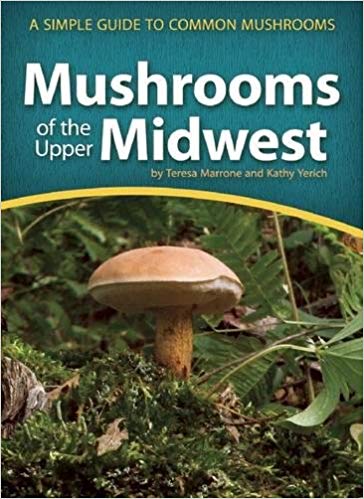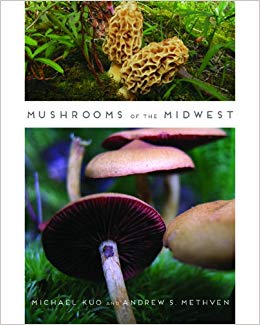No, we cannot list all the kinds of mushrooms that grow in Michigan. Why not? Well, for starters, there are roughly 2,500 species[i].
We can’t list just the edible ones, either, first because there are at least 60 of those. Second, it’s not entirely clear which are edible and which are not—some mushrooms can be eaten with no ill effects on one occasion, then make the same person very sick on the next. The problem may be variation within the mushrooms, multiple species (some poisonous, some not) being miss-classified by scientists as a single species, a toxin that gradually accumulates in the eater’s body, or some other issue. There may be as many as 100 edible species in the state. There are also at least 50 that are known to be toxic, some mildly so, but others deadly.
The fact that 100 plus 50 does not equal 2,500 shows how little we still know about mushrooms!
What we can do is list some of the more interesting mushrooms in the state of Michigan.[ii][iii].
Our Recommended Field Guides
COVER | TITLE | Header | ||
|---|---|---|---|---|
OUR #1 RATED | ||||
Edible Wild Mushrooms in Michigan
Please do not go out foraging for the table without extensive experience identifying mushrooms. It’s an interesting fact of human neurology that the brain does not perceive details it has not learned to consider important through repeated practice. That means that mushroom species that look very different to an expert mycophile might look exactly alike to a novice. And mistakes kill people. At the minimum make sure you reference a quality field guide or even better make a spore print. It also doesn’t hurt to come prepared with proper hunting gear like a mushroom knife, and bag or basket.
Also, please research and follow all relevant cautions for each species before sampling (many must be cooked, some cannot be consumed with alcohol, and so forth).
Mushrooms aren’t inherently more dangerous as food than plants, but they do play by different rules, and it’s important to learn those rules before eating.
Morels (Morchella sp.)
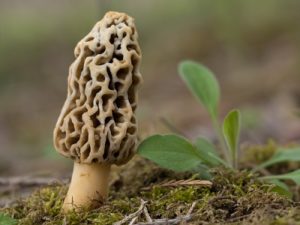
Morels are very popular among Michigan mushroom-hunters, favored by some above all other mushrooms. Their pitted appearance, combined with a hollow stem partly or completely fused to the cap, is distinctive—although false morels and early morels could be mistaken for them by the unwary, and both are considered poisonous. Curiously, morels, despite their fame as table fare that “everybody knows” are safe, do sometimes make eaters ill. Also curiously, morels are so variable that foragers have given multiple common names to single species and also lumped multiple species in under a single name. It’s easier just to call them all morels and get on with deciding whether to eat them.
Chanterelles (Cantharellus sp.)

At least three species of chanterelles grow in Michigan, and all are edible—most are considered choice. Chanterelles, like their (also edible) cousins, the trumpets, are very distinctive for their vase-like shape with ridges, rather than gills, on their undersides. Once a forager learns to see the difference between gills and ridges, identifying chants as a group as easy—until then, though, the unwary might accidentally pick a poisonous jack o’lantern instead.
Oyster Mushrooms (Pleurotus sp.)
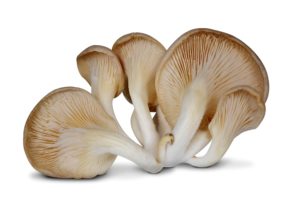
Michigan has at least three native oyster mushroom species, all three of them edible, with a soft texture and a delicate flavor. And although the evidence is preliminary, some studies have suggested various oyster mushroom species as sources of possibly medicinal substances. All three typically grow in clusters from wood and have short, often off-center stems and a pale color.
Hen-of-the-Woods (Grifola frondosa)
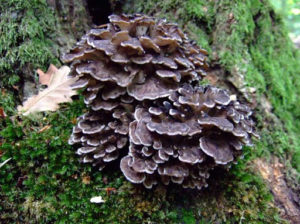
Not to be confused with chicken-of-the-woods (some species of which also grow in Michigan), hen is the same as the Japanese maitake, a rosette of gray leaf-like structures vaguely resembling a pile of chicken feathers. It grows from dead wood and is a choice edible, pairing oddly well with melted cheese.
Michigan Truffle (Tuber canaliculatum)

The Michigan truffle[iv] grows in some of the Eastern Seaboard states of the US, as well as in Michigan, but its range is fairly limited. It is indeed a real truffle and is hunted with truffle-sniffing dogs for use in restaurants. With the proper harvesting technique, the same patch will go on producing for many years. Truffles are mycorrhizal, making them difficult to cultivate, though some people sell trees already inoculated with the fungus. There are inedible truffle species as well, but none closely resemble the Michigan truffle.
The Blusher (Amanita amerirubescens)
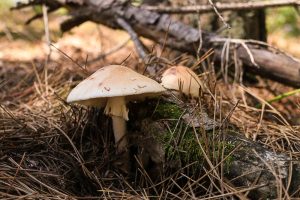
We can’t in good conscience recommend anybody eat this one, since it has look-alikes that can kill you and doesn’t taste all that good anyway, but it’s an interesting edible to know about and does grow in Michigan[v]. There are actually multiple edible species that bear the common name of blusher, all very similar to each other, and some doubtless not yet described by science. All have white flesh that bruises red, and, unlike most Amanitas, lack a distinct cup or volva at the base.
Magic Mushrooms in Michigan
Yes, there are hallucinogenic mushrooms growing wild in Michigan—several species, although not the famous Psilocybe cubensis. And although possession and use of hallucinogenic mushrooms has been decriminalized in at least one Michigan jurisdiction[ix], these are still crimes according to both state and Federal law in Michigan, and penalties can be severe[x].
There are at least 12 species native to Michigan that contain psilocybin[xi], plus Amanita muscaria, which contains an unrelated active substance. The following is only a sampling of a few of Michigan’s “active” species.
Blue Foot (Psilocybe caerulipes)
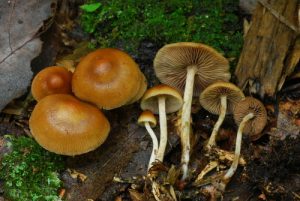
Blue foot[xii] gets its name from the bluish color often found on the base of the stem, especially in dried specimens. Like many psilocybin-containing mushrooms, it also bruises blue. Overall, it is brownish or greenish-brown. Unlike many Psilocybes, it usually lacks a ring. It is considered weak to moderate in potency, and is difficult to find growing wild.
Psilocybe ovoideocystidiata
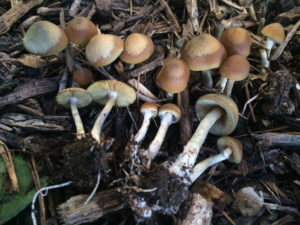
Like many “magic” mushrooms, P. ovoideocystidiata[xiii] has no common name. It’s also a relatively recent discovery, which may explain why some sites list it as occurring in Michigan while others do not—its range may not yet be well-known. It is variable in color, and can be anything from brown to white, with blue or green bruising. It does have a ring. This species is considered highly potent.
Yellow Gym (Gymnopilus luteus)

Yellow gym, like some of its relatives, does contain psilocybin, but must also contain something else because the subjective experience of taking them is markedly different[xiv]. It is thinner-stemmed than either laughing gym species, and as the name implies is yellowish, both inside and out. It also has a more limited geographic range than the others[xv].
Fly Agaric (Amanita muscaria var. guessowii)
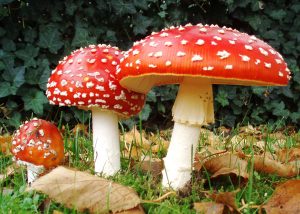
Although “fly agaric” is the accepted common name, it’s more often referred to by its scientific name. This species has a very long history of use for religious and spiritual purposes and is therefore often associated with fairies and magic in art—to the point that many artists now treat it as a sort of generic mushroom, apparently without realizing it has greater significance. This is the mushroom with a red cap with white spots or warts, although some subspecies are more often orange or yellow. Fly agaric is not as popular with recreational users as the Psilocybes are, for several reasons. Most obviously, not all subspecies are reliably psychoactive (though this one is[xvi]) and it is an Amanita, meaning it has look-alikes that can kill you. Even correctly identified, fly agaric causes mild but very unpleasant illness unless properly prepared. And even under ideal circumstances, this mushroom is rarely hallucinogenic in the strict sense. It typically causes mild sensory distortion, a very altered frame of mind (which some find spiritually useful), and then sleep.
Poisonous Mushrooms in Michigan
Remember that the following is not anywhere near an exhaustive list, only a few out of more than fifty.
Eastern Destroying Angel (Amanita bisporigera)
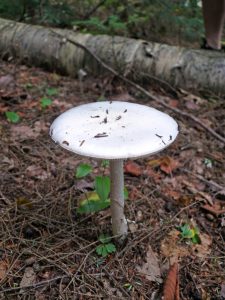
As the name, destroying angel, implies, this mushroom is among the most toxic in the world[vi]. Although its potency varies, it often bears enough toxin to kill an adult human—and its toxin has the creepy characteristic of allowing the victim to feel better for a few days after the initial symptoms pass. Then major organs begin to fail. As is often the case with mushrooms, this “species” appears to actually be a group of several almost-identical species, all of them usually white but occasionally tan or pink or yellow. The white flesh does not bruise but, like the blusher, it, too, usually lacks a volva.
False Morel (Gyromitra esculenta)
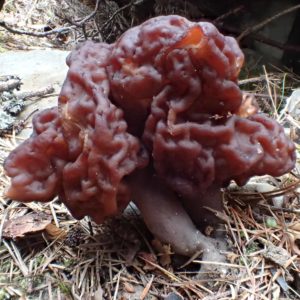
The Gyromitras are collectively called false morels, but this is one of the better-known. It and its kin are also the subject of controversy, with some insisting they are poisonous and others insisting they are not (at least not when properly cooked). It does seem clear this species causes sickness sometimes but not at other times, and the toxin may be able to accumulate in the human body, meaning a person can eat them for years without apparent ill-effects and then quite suddenly get very sick. But the toxin level may also vary significantly. Though blockier than most true morels, there is a notable resemblance, except this species and its kin have wrinkled, rather than pitted, caps.
Eastern Jack O’Lantern Mushroom (Omphalotus illudens)
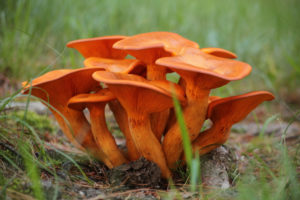
The eastern jack[vii] is well-known for two things: one, its gills sometimes glow in the dark (the light is, at best, faint); and two, many people eat it by mistake and spend the next several days very, very sick. The problem is that, like one of the most sought-after chanterelle species, this mushroom is orange. It doesn’t look like a chanterelle otherwise, but inexperience or wishful thinking can lead a person to get distracted by the color.
Deadly Galerina (Galerina marginata)
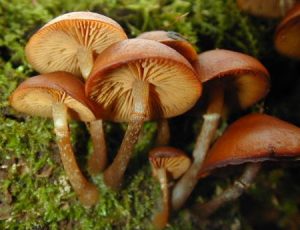
As the name implies, this is another that can kill you[viii]. It is small, plain-looking, and brown, but it has at one close look-alike that is edible. It also bears a definite resemblance to several species of “magic” mushrooms, and is an excellent reason not to go in search of wild “magic” without real expertise in mushroom identification. Not all forms of magic are benign.

My name is Austin Collins.
I've dedicated my life to Mushrooms.
I believe Mushrooms are the best kept secret when it comes to health and well being.
For that reason, I would like to share a company with you that in my opinion makes the best mushroom products on the market.
The company is called Noomadic Herbals, my favorite supplement they make is called "Mushroom Total".
I take their products every day and they have helped me think better and have more energy. Give them a try.
-Austin
References:
[i] Jarvie, M. (2017). Identifying Wild Michigan Mushrooms That Are Safe to Eat. Michigan University Extension
[ii] Seltenright, Sr., C. (n.d.). Species List: Michigan Species List (159).
[iii] Zoellner, A. (2019). Michigan Mushroom Season. Travers City Record-Eagle
[iv] (2019). Tuber canaliculatum. Midwest American Mycological Information
[v] Bergo, A. (n.d.). Amanita amerirubescens.
[vi] (n.d.). Amanita bisporigera. Amanitaceae.org
[vii] (n.d.). Omphalotus illudens (Schwein.) Bresinsky & Besl—Jack O’Lantern.
[viii] (n.d.). Galerina marginata (Batsch) Kühner—Funeral Bell.
[ix] Meloni, R., Hutchinson, D. (2020). City Council Votes to Make Psychedelic Mushrooms Legal in Ann Arbor. ClickonDetroit
[x] (n.d.). Psilocybin in Michigan: Magic Mushrooms in MI, USA, Legal Guide. Psilocybin
[xi] XeioZism (2016). Qestion(s) About Wild Magic Mushrooms in Michigan.
[xii] (n.d.). Psilocybe caerulopes (Peck) Sacc.. Shroomery
[xiii] (n.d.). Psilocybe ovoideocystidiata Guzman et Gains. Shroomery
[xiv] Psycho Gnome (2014). Gymnopolus luteus found in Wisconsin (With Trip Report). Shroomery
[xv] Kuo, M. (2012). Gymnopilus luteus.
[xvi] Iavod (2006). Muscaria var. Guessowii: A Brief Analysis. Shroomery


